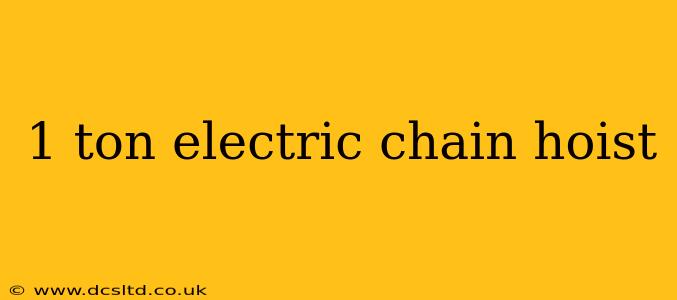Choosing the right electric chain hoist can significantly impact efficiency and safety in your workspace. This comprehensive guide explores the key aspects of 1-ton electric chain hoists, helping you make an informed decision. Whether you're a seasoned professional or a first-time buyer, understanding the nuances of these powerful tools is crucial.
What is a 1 Ton Electric Chain Hoist?
A 1-ton electric chain hoist is a lifting device capable of lifting a load of up to one metric ton (approximately 2,205 pounds). It uses an electric motor to power a chain mechanism, enabling precise and controlled lifting and lowering of heavy objects. These hoists are incredibly versatile and find applications across various industries, from manufacturing and construction to warehousing and maintenance. Their compact design and relatively lightweight nature (compared to the load they can lift) make them ideal for a wide range of lifting tasks.
What are the Different Types of 1 Ton Electric Chain Hoists?
Several factors differentiate 1-ton electric chain hoists, influencing their suitability for specific applications. These include:
- Suspension: Hoists are typically either hook-suspended (hung from a fixed point) or trolley-mounted (capable of moving along an I-beam or other support structure). Trolley-mounted hoists offer greater flexibility for positioning the load.
- Power Source: Most 1-ton electric chain hoists run on single-phase or three-phase power. Single-phase units are commonly used in lighter-duty applications and residential settings where three-phase power isn't readily available. Three-phase units are more powerful and better suited for heavy-duty, continuous use.
- Features: Advanced features like variable speed control, limit switches (preventing over-lifting or lowering), emergency stops, and overload protection enhance safety and operational efficiency. Some models incorporate radio control for remote operation, improving safety and convenience.
How Much Does a 1 Ton Electric Chain Hoist Cost?
The cost of a 1-ton electric chain hoist varies considerably depending on the factors mentioned above, as well as the brand and manufacturer. Entry-level models may be relatively inexpensive, while those with advanced features and heavy-duty construction will command a higher price. It's crucial to balance cost with the requirements of your specific lifting needs, prioritizing safety and reliability.
What are the Safety Features to Consider When Choosing a 1 Ton Electric Chain Hoist?
Safety should always be the top priority when selecting any lifting equipment. Essential safety features for a 1-ton electric chain hoist include:
- Overload Protection: This prevents the hoist from being overloaded, protecting both the equipment and personnel.
- Emergency Stop Button: Easily accessible and clearly marked for immediate power shutoff in emergencies.
- Limit Switches: These prevent the chain from being over-wound or unwound, avoiding potential damage and accidents.
- Thermal Overload Protection: This protects the motor from overheating during extended use.
What is the Lifespan of a 1 Ton Electric Chain Hoist?
The lifespan of a 1-ton electric chain hoist depends heavily on its usage, maintenance, and the quality of its construction. With proper maintenance and responsible use, a high-quality hoist can last for many years. Regular inspections, lubrication, and prompt attention to any signs of wear and tear are crucial for extending its operational life.
How Do I Maintain a 1 Ton Electric Chain Hoist?
Regular maintenance is essential to ensure the safety and longevity of your 1-ton electric chain hoist. This typically includes:
- Visual Inspections: Regularly check for any signs of damage, wear, or loose components.
- Lubrication: Keep the chain and moving parts properly lubricated to prevent wear and tear.
- Functional Tests: Periodically test the hoist's lifting and lowering functions to ensure they're operating correctly.
By carefully considering these factors and investing in a quality 1-ton electric chain hoist with appropriate safety features, you can significantly enhance safety and productivity in your workspace. Remember to always consult with a qualified professional for guidance on selecting and using lifting equipment.
